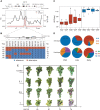Dissection of the Pearl of Csaba pedigree identifies key genomic segments related to early ripening in grape
- PMID: 36440478
- PMCID: PMC9922404
- DOI: 10.1093/plphys/kiac539
Dissection of the Pearl of Csaba pedigree identifies key genomic segments related to early ripening in grape
Abstract
Pearl of Csaba (PC) is a valuable backbone parent for early-ripening grapevine (Vitis vinifera) breeding, from which many excellent early ripening varieties have been bred. However, the genetic basis of the stable inheritance of its early ripening trait remains largely unknown. Here, the pedigree, consisting of 40 varieties derived from PC, was re-sequenced for an average depth of ∼30×. Combined with the resequencing data of 24 other late-ripening varieties, 5,795,881 high-quality single nucleotide polymorphisms (SNPs) were identified following a strict filtering pipeline. The population genetic analysis showed that these varieties could be distinguished clearly, and the pedigree was characterized by lower nucleotide diversity and stronger linkage disequilibrium than the non-pedigree varieties. The conserved haplotypes (CHs) transmitted in the pedigree were obtained via identity-by-descent analysis. Subsequently, the key genomic segments were identified based on the combination analysis of haplotypes, selective signatures, known ripening-related quantitative trait loci (QTLs), and transcriptomic data. The results demonstrated that varieties with a superior haplotype, H1, significantly (one-way ANOVA, P < 0.001) exhibited early grapevine berry development. Further analyses indicated that H1 encompassed VIT_16s0039g00720 encoding a folate/biopterin transporter protein (VvFBT) with a missense mutation. VvFBT was specifically and highly expressed during grapevine berry development, particularly at veraison. Exogenous folate treatment advanced the veraison of "Kyoho". This work uncovered core haplotypes and genomic segments related to the early ripening trait of PC and provided an important reference for the molecular breeding of early-ripening grapevine varieties.
© American Society of Plant Biologists 2022. All rights reserved. For permissions, please e-mail: journals.permissions@oup.com.
Conflict of interest statement
Conflict of interest statement. The authors declare no conflicts of interest.
Figures





Similar articles
-
Selection of candidate genes controlling veraison time in grapevine through integration of meta-QTL and transcriptomic data.BMC Genomics. 2019 Oct 15;20(1):739. doi: 10.1186/s12864-019-6124-0. BMC Genomics. 2019. PMID: 31615398 Free PMC article.
-
Transcriptomic analysis of temporal shifts in berry development between two grapevine cultivars of the Pinot family reveals potential genes controlling ripening time.BMC Plant Biol. 2021 Jul 7;21(1):327. doi: 10.1186/s12870-021-03110-6. BMC Plant Biol. 2021. PMID: 34233614 Free PMC article.
-
Comparative RNA-Seq profiling of berry development between table grape 'Kyoho' and its early-ripening mutant 'Fengzao'.BMC Genomics. 2016 Oct 12;17(1):795. doi: 10.1186/s12864-016-3051-1. BMC Genomics. 2016. PMID: 27729006 Free PMC article.
-
Berry ripening: recently heard through the grapevine.J Exp Bot. 2014 Aug;65(16):4543-59. doi: 10.1093/jxb/ert395. Epub 2013 Nov 27. J Exp Bot. 2014. PMID: 24285825 Review.
-
Gaál Csaba: Sebészet - tizenkettedik, teljesen átdolgozott és bővített kiadás, videóillusztrációkkal.Magy Seb. 2025 May 12;78(1):15-16. doi: 10.1556/1046.2025.10005. Magy Seb. 2025. PMID: 40354123 Review. No abstract available.
Cited by
-
DNA Methylation Is Crucial for 1-Methylcyclopropene Delaying Postharvest Ripening and Senescence of Tomato Fruit.Int J Mol Sci. 2024 Dec 28;26(1):168. doi: 10.3390/ijms26010168. Int J Mol Sci. 2024. PMID: 39796026 Free PMC article.
-
Genotyping-by-sequencing-based high-resolution mapping reveals a single candidate gene for the grapevine veraison locus Ver1.Plant Physiol. 2024 Sep 2;196(1):244-260. doi: 10.1093/plphys/kiae272. Plant Physiol. 2024. PMID: 38743690 Free PMC article.
-
CHH hypermethylation contributes to the early ripening of grapes revealed by DNA methylome landscape of 'Kyoho' and its bud mutant.Hortic Res. 2024 Oct 14;12(1):uhae285. doi: 10.1093/hr/uhae285. eCollection 2025 Jan. Hortic Res. 2024. PMID: 39866961 Free PMC article.
-
Focus on fruit crops.Plant Physiol. 2023 Jul 3;192(3):1659-1665. doi: 10.1093/plphys/kiad259. Plant Physiol. 2023. PMID: 37148289 Free PMC article. No abstract available.
-
The genetic characterization of grapevines prospected in old Serbian vineyards reveals multiple relationships between traditional varieties of the Balkans.Front Plant Sci. 2024 Jul 11;15:1391679. doi: 10.3389/fpls.2024.1391679. eCollection 2024. Front Plant Sci. 2024. PMID: 39055361 Free PMC article.
References
-
- Borges A, Rosa MS, Recchia GH, Queiroz-Silva JRD, Bressan EDA, Veasey EA (2009) CTAB Methods for DNA extraction of sweetpotato for microsatellite analysis. Sci agric 66(4): 529–534
Publication types
MeSH terms
LinkOut - more resources
Full Text Sources

